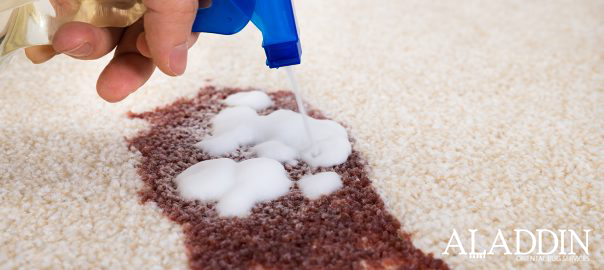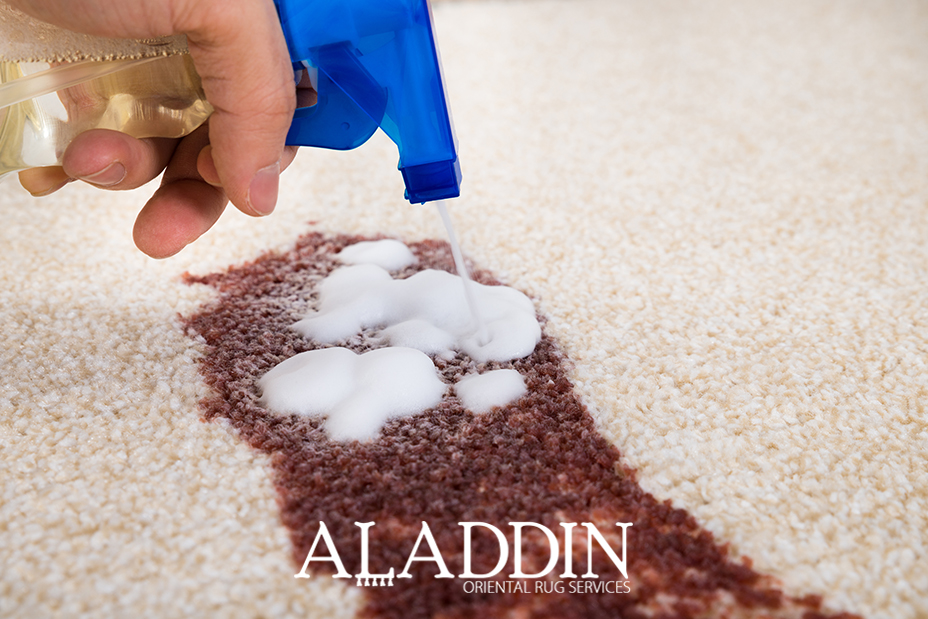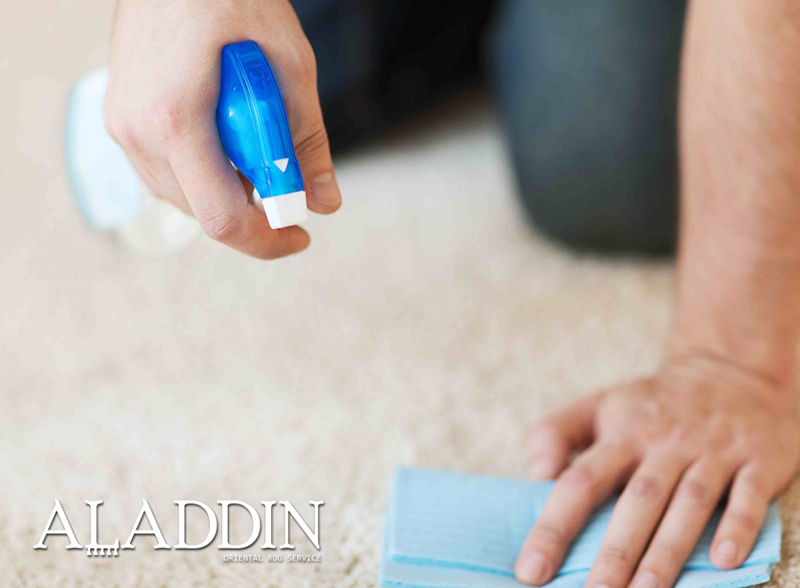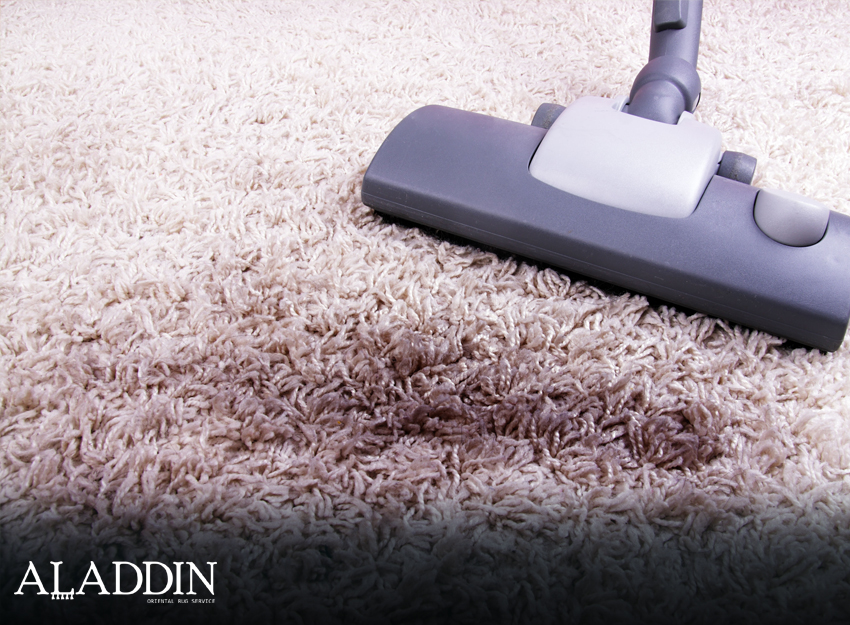With the warmth and coziness of holiday decor, your carpets and rugs will likely come across some risk of being stained with candle wax. There’s no replacement of the feeling of being in a cozy home with lit candles burning bright – but wax can pose a danger to your pristine rugs. Here’s a guide from the rug cleaning experts at Aladdin on how to remove wax from your carpets or rugs.
Tag Archives: Rug Cleaning

One of Thanksgiving’s classic dishes is cranberry sauce – the perfect tart complement to turkey or savory vegetable dishes, rife with all the fresh savor of Autumn. However, despite its magnificent deliciousness, cranberry sauce is a notorious carpet stainer, perhaps only rivaled by the dastardly beet. Here’s Aladdin’s guide for carpet cranberry sauce stain removal, so you can remain calm, confident, and really enjoy your family get together this Thanksgiving.
-
First, scoop up the majority of the sauce with a knife, being careful not to press it down into the carpet fibers (if it’s the more solid, gelatinous kind or has whole cranberries,) then blot the area with a clean cloth or paper towel to absorb as much of it as possible. Then wet a small towel with water, and continue blotting away.
-
Cranberry sauce produces a stain due to it’s tannins – these stains can be removed easily with detergent and hot water.
-
Don’t use natural soap for this, as natural soap make tannins harder to remove from carpets. Make sure, if you’re using bleach, that you use color safe bleach.
-
If the stains don’t come off, repeat the above steps. Just don’t use heat to dry it, as it will set the stain in.
-
If the Cranberry sauce isn’t 100% natural and has food coloring, use an oxygen based color safe bleach like OXO Brite-in or OxiClean according to package directions. Dip a clean rag into the solution and work from the outside edge of the stain inwards in order to prevent spreading it around. Don’t’ get it too wet. Let the solution stay on the stain for at least a half an hour before blotting it up.
-
Use a clean white rag to blot away any moisture, but don’t rinse it. Oxygen bleach usually turns into water within a couple hours – simply let it air dry away from direct sunlight or heat. Then vacuum to restore the pile of the carpet.
-
It’s essential to remember not to get the fabric of the carpet too wet with the cleaning solution as it can cause mildew.
-
If none of these steps work, contact a licensed carpet professional, like those at Aladdin!
For the majority of people, oriental rugs can be considered one of the highest investments people make in home decoration. The payoff is good though – since they add light to a room’s ambience as well as a soft surface for hanging out on top of. However, if you want an oriental rug to last for a long time, you need to make sure that it’s maintained well through regular cleaning. The best way to treat a carpet or rug is to clean it yourself regularly – as this way you’re greatly reducing the chance of any damage occurring, as well as increasing the longevity of your rug.
Supplies
You will need a vacuum, gloves, a bucket, a mild dish soap or rug shampoo, a sponge, a brush, a squeegee, and water.
Cleaning Process
Step One: Vacuuming
First vacuum the rug’s top and bottom side to get rid of any dirt or dust.
Step Two: Color Testing
Mix the mild soap or cleaner with warm water (not hot) and try applying it to a tiny corner of the rug to ensure it doesn’t mess up the colors.
Step Three: Washing
Use a wet brush or sponge to lather the solution deep inside the rug and allow it to remain a few minutes before rinsing it off.
Step Four: Rinsing
Rinse off the entire rug with a hose so that no soap suds remain on it.
Step Five: Removing Excess Moisture
Use the squeegee to remove as much water as you can from the rug, in the direction of the nap.
Step Six: Drying
Lay out the rug on a flat surface to dry one side at a time.
Step Seven: Relaxing the Rug
Use a vacuum or a soft brush to help loosen up the rug’s fibers to restore their softness and suppleness – as they may have gotten stiff during the washing process.
Frequency
While it’s very important to wash rugs when they are dirty, and they do get dirty often – it’s probably not the best approach to simply wash it all the time even when it’s clean. You can test to see if a rug is dirty enough to merit washing by picking a corner of it up and letting it fall to the floor – if a cloud of dust appears, it needs washing. Additionally, rugs need washing when you can visibly see the dirt on them, or if they smell weird. By taking care of soiled rugs as soon as possible, you will greatly extend its softness over time.
Some people think that when rugs need to be cleaned they can just beat them against a hard railing to get rid of all the dust. However this isn’t the best approach because it doesn’t provide the most thorough clean. Most fine rugs are made of wool. Wool not only acts as a warm surface, but also as a filter for removing dampness, dust, and bacteria from the air. In many ways, a wool rug or carpet acts as an air filter. Unfortunately, that makes them susceptible to becoming quite dirty over time – so dirty that a simple beating won’t work at all to clean it.
How to know it’s dirty enough to warrant a cleaning
If you want to check how dirty your rug is and if it needs a professional clean, pick up a corner of the rug and kick it’s underside.. If dust and wool fiber fly out don’t worry, that’s normal. But if a massive cloud flies out – it’s probably time to get your rug professionally cleaned. Another cleanliness test can be conducted by rubbing the rug’s fabric f or 10 to 15 seconds, and if your hand comes off dirty, it certainly needs a clean.
Cleaning Methods
The best way to clean is by placing a rug in a utility room or area where you don’t mind getting dirty. A somewhat clean outdoor area is the best. First, vacuum both sides of the rug. Then shampoo the rug with cool water and soap – the best kind is a rug shampoo. Never use ammonia or a harsh detergent. Always test the shampoo against any color run in a small area of the rug first. Then use a soft long hair brush or a firm sponge that doesn’t shed. Brush or rub it against the rug in the direction of the weave when it’s fully covered in soapy water. Wash fringes as well, and always brush them away from the rug. Then rinse off the rug with water – you can use a window squeegee to get out all the excess water – but always do so in the direction of the weave. Lay out the rug flat to dry, and once the exposed side feels fully dry, flip it over to allow the other side to dry. If the rug is way too stiff, brush it gently or vacuum it lightly. If the stain still remains, take it to a professional rug cleaner.
Similar terms, different processes
You’d be surprised how many people don’t know the difference between carpets and rugs. Usually the terms are somewhat interchangeable on a vernacular level, but in fact they refer to different processes. In this blog post I’ll detail the differences between carpet cleaning and rug cleaning.
Carpet cleaning refers to cleaning pre-installed wall to wall carpets. There’s many potential methods one can use to do so, but hot water extraction is one of the best methods of removing impacted and embedded allergens, mold, dirt, and dust.
Rug cleaning
This refers to the cleaning of removable rugs that can be rolled up. This process entails sanitization with spray – in cases of odor damage due to pet urine- in order to kill any remaining bacteria. Afterwards, the rug will be completely immersed in a solution that neutralizes the heavy alkaline salts within the urine, allowing for a more complete removal of the urine residue. After the rug has absorbed the neutralizer for enough time, it will be rinsed off, and wrung out to remove all moisture. This part of the process gets rid of any odor.
The rug will now be given a hand scrub on both sides with a shampoo specifically matched for the rug’s material and construction. After the rug receives a thorough hand washing, it will be rinsed off and wrung out again, groomed with a brush, and hung to dry in a climate controlled heat room. After the rug dries, it will be closely inspected for any remaining soil, stains, or spots. If there any, the rug will be subjected to the entire process again. It’s worthwhile to note that it is completely essential that all water and moisture from the rug is thoroughly extracted – as it needs to be completely dry.
As the thermometer creeps up and Spring and Summer arrive, many people will begin sneezing – a sign that allergy season has officially started. While the warmth of the sun surely will be welcome over the freeze of a few months ago, it also brings about a large amount of allergens – namely pollen which can make it’s way into the home, and stick inside upholstery and carpets. By utilizing regular carpet cleaning to eliminate impacted allergens and grout cleaning to remove any mold from tiles, you can prevent your allergies from getting that bad, so that instead of suffering from clogged up sinuses and a runny nose, you can get outside and enjoy the much nicer weather. Here’s some great tips for keeping your home healthier and allergy free.
Be Aware of What your Triggers Are
It’s important to learn what allergens trigger allergic reactions in you or your family members. The most common allergy triggers are animal dander, pollen, dust mites, mold spores, and cockroaches. If your triggers are outdoor alxlergens, keep your windows closed. If they are indoor allergens, open all the windows in order to air out the entire house.
It can happen to any household, at any time. There’s a billion ways it can happen. You walk in, and notice that the entire floor is soaked. This is the extreme scenario. In another, common and more subtle version, a small unchecked leak causes thousands of dollars of damage over the course of a long period of time. Here’s the 4 major causes of residential water damage that require professional intervention.
Nature
You can’t help this. Homes in certain locations are more vulnerable than others. Natural disasters like hurricanes or storms can flood your home with water – and if your home is within a flood zone, just a moderate rainstorm can cause rampant overflowing in nearby creeks or streams, causing water to enter your home. Earthquakes or tremors can make your water pipes crack, causing flooding. There’s no way to prevent a natural disaster from happening, but when it does, it’s important to do everything that you can to safely mitigate the damage.
There’s no doubt about it; chocolate is simply the best. Even if it’s not at the bottom of the food pyramid, we can all agree that chocolate simply makes life better. However, regardless of how yummy it is, we simply can’t deal with indelible chocolate stains on your favorite carpet or rug. Chocolate stains are some of the most deep, hardest to remove stains around. Let’s say you’re already dealing with a chocolate stain; here’s how to treat it.
Carefully Scrape it Off
Since chocolate melts quickly in higher temperatures and quickly solidifies in low temperatures, carpets and rugs can get ruined by melted chocolate that becomes a mold as the temperature drops. If you notice dried chocolate on your rug or carpet, try gently rug cleaning method of scraping it off – the key word is ‘gentle’ as you can cause more structural damage to the rug if you’re too rough. While this won’t completely remove the stain, it will help make it less thick and much easier to handle. This way you know that even if the carpet or rug gets exposed to higher temperatures that the chocolate won’t re-melt and spread, causing a larger stain.
What are draught markings?
Draught markings are dark, dirty, or soiled spots that appear on carpets on the edges of the walls or under doorways. Sometimes they can even be found in other areas of the rug along the pattern of the floorboards.
Draught markings are otherwise known as filtration soiling, fogging, or dust markings. They are caused by contaminated air with microscopic dirt particles – the carpet filters the dirt from the air, causing an ugly stain on the carpet or rug.
Carpets can be soiled by contaminated air in these ways:
- It passes upwards through gaps between the floorboards.
- Through gaps under the skirting boards.
- Through holes within the carpet caused by carpet fitting devices or nails.
- Through gaps under doors with high air concentration.
- Through gaps under the underside of curtains, which usually creates a wavy line pattern.
- Through air vents that are positioned close to the carpet.
How can we prevent draught markings?
The most effective way of preventing these unsightly marks from marring your carpets is to draught proof your carpet – this can be accomplished by putting hardwood sheets above the existing floorboards, taping their joints together to prevent air leaks, putting paper on top of it for extra protection, and using a flexable weather stripping like mastic to seal any space between the floor and the board. If all these steps are followed it’s highly unlikely you’ll have the necessary air currents to create draught markings.
How can we cure draught markings?
Unfortunately it’s quite hard to completely remove evidence of a draught marking. Since the soiling of the rug happens on a microscopic level, the oil of the dirt might remain bonded to the fibers of the carpet. The ability to remove the stain depends on what kind of soil it’s made of and how long it has been on the carpet. The fresher the stain, the easier it is to remove. Venting marks – the marks that run the perimeter of rooms or rugged stairs, is caused by the limitation of upright vacuum cleaners to get right up to the carpet’s edge – prevented from doing so by bulky casing. Eventually all the unvacuumed dirt in the edges accumulates and becomes a serious black stain. We recommend the use of a crevice vacuum, or vacuum plug in to help suck up all the dirt caught up in the corners of your rug.
Picture this: you’re relaxing at home, enjoying a glass of red wine on the couch – allowing yourself to decompress after a long workday or busy weekend – when the worst happens. You slip. A noise startles you. You trip. The important thing is that the glass slips out of your grib, and it’s almost like it’s happening in slow motion – you watch, dejected, as a giant red stain appears on your perfect, (formerly) immaculate carpet.
What should you do? What emergency measures should you take? Should you be reaching for the bleach? Does cold water take out stains… or is it hot water? Try not to panic. It may look like dire circumstances but you can absolutely remedy the situation. Here’s the steps to follow so you can do that.
Soak up all the excess wine
Before you reach for any other cleaning solutions, grab an absorbent cloth and start blotting the stain, using a fresh (not absorbed yet) area of the cloth each time you blot down – the goal is to absorb as much liquid as you possibly can from the carpet. After you’ve absorbed as much liquid as you can, pour some clean water on the stain, and continue blotting it. Repeat this a few times – but you don’t want to completely saturate the couch with water, rather make sure that as much of the surface stain transfers onto the blotting cloth as possible. This will make the entire cleanup process much more effective.
Test all cleaners before final use
If you have a dark colored carpet, or a delicate antique rug, you don’t want to be using a harsh or intense cleaning solution that could degrade or abrade the fabric, damaging it. We recommend testing a small hidden spot of the fabrics reaction the solution before using it on the rest of it – this makes sure that the quality and color of the carpet won’t be affected by it – which could be irreversible.
Choose your Weapon
Carpet Stain Remover
The directions for this plan varies based on whatever brand you’re using – we recommend simply following the directions on the label if you don’t want to encounter any accidents.
Baking Soda
Mix baking soda and water on a 3:1 ratio until it’s a paste, and pat some of the paste into the stain completely. Once dry, vacuum off; keep in mind that for extra power try mixing baking soda with hydrogen peroxide.
Club Soda
The internal carbonation in a bottle of club soda helps it remove stains efficiently – we recommend using it when you’re blotting (instead of water.)
Vinegar
Vinegar works great on red wine stains – mix it with a bit of water and blot the stain – when you’ve done all that you can, blot afterwards with a bit of dish soap.
Dish Soap
Mix soap and hydrogen peroxide, apply it to the stain, allow it to rest and penetrate the stain and then blot it away.
Salt
Poar a huge amount of salt onto the stain and give it some time as it absorbs the time – this should be a fantastic immediate post-stain therapy – simply vacuum to finish up.
See what you’ve done
If you were not able to get rid of the entire stain (as many people are) it’s wise to call in professional assistance. The expert cleaners at Aladdin are prepared with top-of-the-line equipment to clean up all stains – including red wine. Although nothing beats a professional carpet cleaning, these tips should do you well in the event of an emergency, It’s wise to keep these items around the house.
-
Aladdin Oriental Rug Services
Aladdin Tips
Allergies
Authentic Rug
Autumn Color Tones
Carpet Cleaning
Carpet Cleaning Mistakes
Carpet Cleaning Tips
Carpet History
Carpet Preservation
Carpet Restoration
Carpet Stain
Carpet Stains
Carpet Tips
Carpet Treatment
Flooding
Floods
Modern Rug
Natural Rug Dyes
Oil Stains
Oriental Carpet Cleaning
Oriental Rug
Oriental Rug Restoration
our oriental rug cleaning company
Persian Rugs
Problems with Hardwood Floors
Professional Rug Cleaning
Rug Cleaning
rug cleaning nj
Rug Cleaning Tips
Rug Color
Rug Dying
Rug Preservation
Rug Repair
Rug Restoration
Rugs
Rug Stain
Rug Tips
Rug Treatment
Stain Remedies
Stain Removal
Stains
Water Damage
water damage rug restoration
Worst Stains









